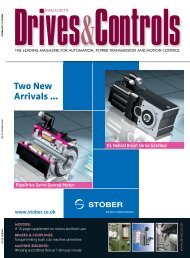New Danfoss VLT® Decentral Drive E cient, reliable and powerful
New Danfoss VLT® Decentral Drive E cient, reliable and powerful
New Danfoss VLT® Decentral Drive E cient, reliable and powerful
You also want an ePaper? Increase the reach of your titles
YUMPU automatically turns print PDFs into web optimized ePapers that Google loves.
Time to<br />
put HMIs<br />
in control?<br />
PLCs AND HMIs<br />
The boundary between HMIs <strong>and</strong> Scada systems is breaking down,<br />
with modern CE-based HMIs offering many of the functions previously<br />
restricted to PC-based systems. Graham Isherwood (left), sales manager<br />
for ABB Open Control Systems, examines this trend <strong>and</strong><br />
considers what it means for the automation market.<br />
The distinction between HMI <strong>and</strong><br />
Scada is becoming increasingly<br />
blurred. Traditionally, an HMI was a<br />
simple interface to a PLC <strong>and</strong> was in the<br />
domain of the machine-builder. Scada, by<br />
contrast, was the “line controller” which<br />
ran on a PC <strong>and</strong> had better functions for<br />
visualisation, trending <strong>and</strong> alarm reporting<br />
– but was usually not cost-effective at the<br />
machine level.<br />
Both technologies have evolved. Scada<br />
vendors now offer Windows CE-based<br />
products that run on HMI hardware, while<br />
HMI vendors are adding features to boost<br />
functionality.<br />
Does this mean that there is now a<br />
simple choice between “large” <strong>and</strong><br />
“small” Scada, or is there an application<br />
niche for high-performance HMI panels,<br />
that are both feature-rich <strong>and</strong> costeffective?<br />
The automation industry has no<br />
accurate definitions for HMI or Scada. The<br />
two terms are often freely<br />
interchangeable – or are simply seen as<br />
being different names for the same thing.<br />
You therefore need to set up a framework<br />
to allow comparisons to be made.<br />
In general, there are two generic<br />
approaches to providing an operator<br />
display – those based on Microsoft’s<br />
Windows CE, <strong>and</strong> those based on fullscale<br />
PCs. Windows CE displays are<br />
probably less obvious to users because<br />
vendors implement their own flash<br />
screens on boot-up.<br />
Microsoft’s CE developments (driven<br />
largely by the requirements of the mobile<br />
phone market <strong>and</strong> by CPU developments)<br />
have resulted in CE becoming a <strong>powerful</strong><br />
platform for HMI applications.<br />
On the PC-based side, you find Scada<br />
<strong>and</strong> DCS. Scada vendors often add (<strong>and</strong><br />
sometimes remove) functions to provide a<br />
CE-based offer, usually offering the same<br />
development tools as for their PC-based<br />
systems. DCS vendors tend to use CEbased<br />
panels for peripheral operator<br />
stations rather than for those found in<br />
control rooms. The boundaries in the<br />
operator display market are therefore<br />
blurred, but this perhaps ignores other<br />
important attributes in the hardware.<br />
What’s missing?<br />
CE devices tend to be more robust than<br />
PCs, <strong>and</strong> thus more <strong>reliable</strong> in the field,<br />
needing no mains power supply (they<br />
operate from 24V DC supplies), no hard<br />
drive (they use flash memory) <strong>and</strong> no fans.<br />
These factors make CE-based HMIs<br />
functionally attractive – even more so<br />
when relative prices are considered, along<br />
with easier installation <strong>and</strong> swap-out.<br />
Another attraction is that the<br />
combination of a CE panel <strong>and</strong> its<br />
associated software is cheaper than the<br />
PC-based Scada alternative. This has a<br />
direct bearing when a system needs<br />
multiple operator stations, <strong>and</strong> the budget<br />
is a maximum of £1,000 per station.<br />
But you might wonder what is<br />
“missing” in a CE-based HMI that you<br />
might regret later on. If the price per<br />
station is lower, then what are you doing<br />
without?<br />
In the past, CE-based systems posed<br />
some development problems, with an<br />
over-dependence on processor types <strong>and</strong><br />
other limitations. In addition, the software<br />
was clumsy <strong>and</strong> required a knowledge of<br />
electronics as well as of automation.<br />
Thankfully this is over. There are now<br />
two sub-divisions within the CE operator<br />
station market – those from vendors that<br />
supply both hardware <strong>and</strong> software, <strong>and</strong><br />
those that supply these elements<br />
separately.<br />
Both approaches have attractions in<br />
terms of squeezing more out of the CE<br />
format. Holistic hardware with software<br />
combinations offer ease-of-use <strong>and</strong><br />
extended, dedicated functions.<br />
If a CE-based panel is going to be costeffective,<br />
it has to offer more for your<br />
money than an equivalent PC-based<br />
system (bearing in mind the software<br />
licencing cost). The front has to look good<br />
(offering a choice of a touchscreen or<br />
function keys), but the detail is at the rear.<br />
Turning an HMI panel around shows its<br />
connections <strong>and</strong> how thoughtfully <strong>and</strong><br />
practically it has been designed. For<br />
example, can you see an RJ-45 Ethernet<br />
connector, a USB socket, a memory card<br />
slot, an old-style D-Sub serial port, a<br />
printer port, a 24V DC terminal, <strong>and</strong> so<br />
on? You should also check the mounting<br />
www.drives.co.uk November/December 2010 39




